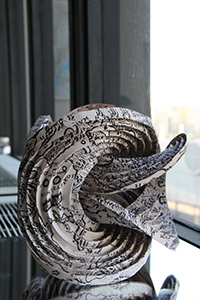49 Reasons Why the Universe Is Beautiful
-
-
slice.mit.edu
- 1
Filed Under
Recommended
[layerslider id="2"] “In MIT and in astronomy in general there does seem to be a pretty big number of people who are secretly artists at heart,” said Zach Berta-Thompson, competition co-organizer with Bryce Croll, both postdoctoral fellows at MIT’s Kavli Institute for Astrophysics and Space Research. “This has been a fun way to get people to crawl out of the woodwork.”
First prize went to the video performance “The Life of a Star in the Flame Nebula.” A team of five performers danced with staffs of fire to act out a star’s formation. The full production team of 14 students and alumni was led by Rachel Bowens-Rubin ‘11, SM ‘12, who drew upon her background in planetary science and musical theater at MIT to choreograph the performance. She explained contests like Dance Your PhD inspired her to educate people about stars by “dancing out the topic to explain it.”

And dance they did. To represent gas collecting, the dancers—their flames each symbolizing a unit of atomic mass—gyrated faster and faster to intensifying electronic music. Eventually, the spinners combined their flames in a central bowl to represent the star formation and the start of fusion. The spinners then acted out a proton-proton chain reaction culminating in the creation of Helium-4.
The video’s captions offered a scientific commentary to the performance with some humor. “Doesn’t science make you feel all warm?” the video asked as Helium-3 was formed. “Maybe it was the 5.49MeV of energy release during the reaction…or the fire.”Seven other works received prizes including “Telescopic Moon, First Quarter,” by Elizabeth Cavicchi ‘78, SM ‘80. Following in Galileo’s footsteps, she observed the moon’s surface through her own tiny telescope and illustrated what she saw in watercolor and ink.

Also receiving an honorable mention was “Selenographia Revisited” by Michael Benson, Erik Demaine, Department of Electrical Engineering and Computer Science assistant professor, and Martin Demaine, a visiting artificial intelligence and computer scientist. An homage to lunar cartographer Johannes Hevelius and his 1647 book Selenographia, this intricately folded origami sculpture re-shapes a page from the seminal work into a dramatic series of geometric turns and twists. “This swirling equilibrium fold represents how space and time are flexible, warping and flexing depending on the forces at work,” the artists write in their description.
“Astrophysics is a very visual field,” said Berta-Thompson. “There’s a lot of space to explore. Literally.”
Visit the Art of Astrophysics online gallery for photos of all submitted works. MIT’s Kavli Institute for Astrophysics and Space Research funded the competition.








Comments
John Wood
Fri, 03/20/2015 10:48pm
When Hannah was just a small child, she was already showing signs of imaginative talent.